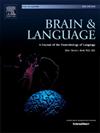工作记忆是否独立影响双语儿童的语言发展?30年的反思
IF 2.3
2区 心理学
Q1 AUDIOLOGY & SPEECH-LANGUAGE PATHOLOGY
引用次数: 0
摘要
1992年,哈林顿提出,工作记忆是成年人发展第二语言的一个关键制约因素,但他指出,需要更有力的证据来证明它对语言的独立影响。本文以双语儿童为研究对象,回顾了近30年来双语者工作记忆研究的进展。我考虑理论和方法上的改变,以避免混淆语言和工作记忆。回顾了工作记忆在双语语言发展中的作用的实证研究,注意到最近关于这一主题的许多研究都考虑了语言如何塑造工作记忆,而不是相反。我还讨论了来自患有发展性语言障碍的双语儿童的证据,这些儿童的语言缺陷部分归因于工作记忆限制。在双语人群中——包括成人和儿童,以及典型和非典型语言学习者——统一证据对于继续推进该领域的发展至关重要。本文章由计算机程序翻译,如有差异,请以英文原文为准。
Does working memory independently influence language development in bilingual children? A 30-year reflection
In 1992, Harrington posited that working memory is a key constraint on the development of a second language in adults but noted that stronger evidence is needed to establish its independent influence on language. In this paper, I reflect on advances in the study of working memory in bilinguals over the intervening 30 years, focusing on bilingual children. I consider theoretical and methodological changes that avoid confounding language and working memory. Empirical work on the role of working memory in bilingual language development is reviewed, noting that much recent work on this topic considers how language could shape working memory, rather than vice versa. I also discuss evidence from bilingual children with developmental language disorder, a population whose language weaknesses have been partly attributed to working memory constraints. Unifying evidence across bilingual populations – including adults and children, and typical and atypical language learners —is important to continue the field’s advancement.
求助全文
通过发布文献求助,成功后即可免费获取论文全文。
去求助
来源期刊

Brain and Language
医学-神经科学
CiteScore
4.50
自引率
8.00%
发文量
82
审稿时长
20.5 weeks
期刊介绍:
An interdisciplinary journal, Brain and Language publishes articles that elucidate the complex relationships among language, brain, and behavior. The journal covers the large variety of modern techniques in cognitive neuroscience, including functional and structural brain imaging, electrophysiology, cellular and molecular neurobiology, genetics, lesion-based approaches, and computational modeling. All articles must relate to human language and be relevant to the understanding of its neurobiological and neurocognitive bases. Published articles in the journal are expected to have significant theoretical novelty and/or practical implications, and use perspectives and methods from psychology, linguistics, and neuroscience along with brain data and brain measures.
 求助内容:
求助内容: 应助结果提醒方式:
应助结果提醒方式:


